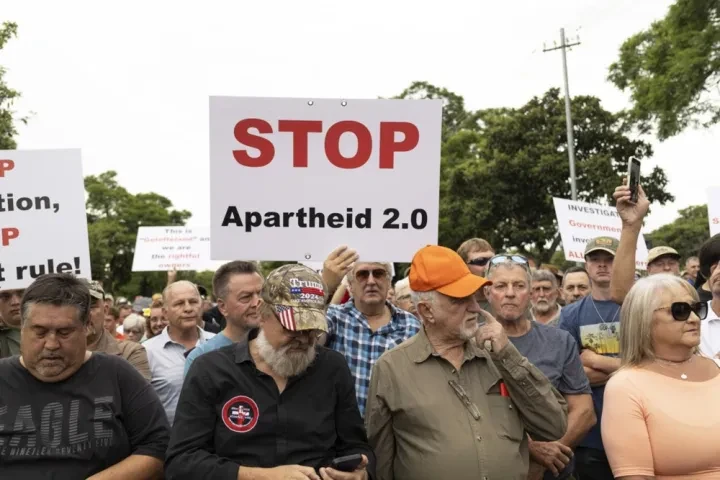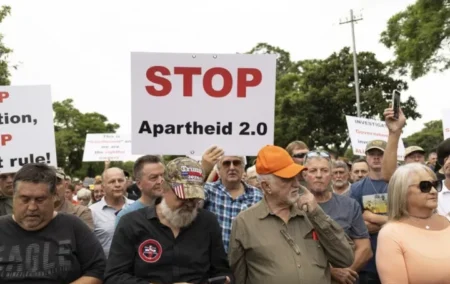One prominent placard at last Saturday’s whites-only pro-Trump demonstration in Pretoria said “STOP Apartheid 2.0”. That needs an answer.
Earlier in the week, I wrote about the Afrikaner nationalists who expressed their gratitude to Donald Trump for offering them refugee status and putting pressure on South Africa to change course on expropriation, racial laws, and alliances with enemies of the US.
That such pressure is likely to be counter-productive, and merely drive the government in the opposite direction, did not occur to them. That carrots, rather than sticks, might achieve better results, did not feature in their simplistic political calculations.
What did feature, according to a photo published in Daily Maverick, is printed on a sign held by a dour-faced Boer in a plaid shirt, standing behind a pair of bearded and beer-boeped throwbacks to the Afrikaner Weerstandsbeweging (AWB). It read, “STOP Apartheid 2.0”.

Unlike youngsters such as the wretched, downtrodden Willem Petzer, the gent holding the placard – wearing classic 1970s undercover cop-style gradient-shade teardrop glasses – looks old enough to have voted for Andries Treurnicht.
Treurnicht was the founder and leader of the official opposition, the Conservative Party, from 1982 to 1993. He was widely known as “Dr. No” for his resolute opposition to any reform of the apartheid system.
Suspend disbelief
Let us not jump to conclusions, however. Let us suppose – however hard it may be to suspend disbelief – that the guy in the photo was instead an anti-apartheid liberal back in the day, who secretly voted for the Progressive Federal Party, owned United Democratic Front literature, and donated to the Institute of Race Relations.
If so, his memory seems to be failing him, 40 years on from the height of the Botha-Treurnicht era. Again, we’ll be generous and note that this is an unfortunate, but not unusual, consequence of ageing.
Given these assumptions, it would be remiss of us not to remind the good gentleman of what Apartheid 1.0 was really like.
While there are superficial similarities in the sense that racial distinctions are still used in various laws and regulations aimed at achieving better representation of black people in the economy and a more equitable distribution of wealth and economic opportunities among the races, today’s dispensation is very far from what apartheid was, both in intent and in practice.
For the record
I should reiterate for the record that I, like other writers at The Daily Friend, and other members of the Institute of Race Relations, advocate a non-racial society, and therefore do not support race-based laws or regulations.
I first called for black economic empowerment to be sunsetted in an article for Maverick magazine back in 2008, since I believed it was achieving diminishing returns while its negative impact on investment trends and the productivity of capital was rising.
I also do not support legal or regulatory discrimination on the basis of ethnic origin, home language, religion, body morphology, or any other immutable personal characteristics. While I support voluntary diversity, equity, and inclusion initiatives, I oppose demographic quotas and other state intervention aimed at social engineering.
I do not support redistribution measures that violate private property rights, beyond restitution of wrongfully confiscated property, providing a basic social safety net, and funding the basic functions of a minimal state mandated to protect individual life, liberty, and property.
Nor do I support the expropriation of property, even with compensation, unless required for a bona fide public purpose such as infrastructure build-out or public utilities. In the vast majority of cases, there’s no such thing as a “public interest” that supersedes private property rights.
And finally, I do not support the ANC, or even the Government of National Unity. I’m a committed anti-socialist and free-market capitalist and oppose the “developmental state” ideology that pursues the mirage of “state-led growth”.
Memory of apartheid
That said, I’d like to refresh the plaid-shirted man’s nebulous memory of apartheid.
Until 1974, the Masters and Servants Acts, dating back to the 19th century, made breach of employment contracts by (largely black) unskilled workers a criminal offence. Desertion, insolence, drunkenness, negligence, and strikes were crimes, for which primarily black people could, and were, arrested.
Our main man might get fired for backchat at work, or get scolded by his wife, but I’m sure he won’t be thrown in jail.
A series of laws restricted the amount of land available for black ownership to 13% of the land area of South Africa. That land was far from urban centres and other work opportunities.
One consequence of this dispensation was a brutal migrant labour system that broke up black families, because male labourers were forced to live in single-sex hostels near employment opportunities, while women were left back home in rural areas to raise children and care for the elderly.
I’m sure our plaid-shirted fellow hasn’t had his family involuntarily broken up by a cold, calculating government over which he had no control.
Segregation
The Group Areas Act of 1950 and various other laws passed both before and after it reserved prime residential property for white people, prohibiting people of other races from owning or renting property there.
This created vast townships on the urban periphery where black people had to reside, far from the town centres, residential suburbs and industrial areas where they worked. Black people who lived in white areas could be, and routinely were, forcibly removed to the locations.
In these townships, until 1976, black people were prohibited from establishing businesses, except for seven self-employment categories, namely general dealerships, native eating-houses, restaurants, milkshops, butcheries, greengrocers, and hawking.
The number and type of businesses allowed in each township were controlled, and limited, by white municipalities. As a consequence, there was no economic development in townships, and the vast majority of township residents were forced to commute long distances to work.
Schools were also segregated. In 1975, the government spent 15 times as much on the education of a white child as it did on the education of a black child. White kids got their textbooks and education largely for free, but black families usually had to pay for both. Ninety percent of teachers in black schools did not have a matric. Most black children barely made it past primary school, if they went to school at all.
I’m fairly certain our police-shades chap is free to choose where he wants to live, how he wants to educate his children, and what business he wants to conduct.
Pass laws, separate amenities and “immorality”
A raft of pass laws and influx control laws, some dating back to the 18th century, created a daunting legal web that established far-reaching controls over black people’s employment, housing, access to land, movement, and citizenship rights.
Between 1916 and 1984, almost 18 million black people are known to have been arrested and prosecuted under these laws.
The oom in our picture is free to get into his bakkie and drive anywhere in South Africa, without being asked for anything more than his driver’s licence. He is also free to buy or rent property wherever he would like and seek work wherever he wants.
Under the old regime, there were separate public amenities – from park benches to beaches to water fountains to bus stops to toilets – for whites and non-whites. Many shops had separate queues and sometimes even separate entrances for white and non-white customers. Many restaurants simply refused to serve non-white customers. Many churches were for white people only.
When I was at school, there were two kinds of buses: the bus, and the k*****bus.
Our friend the protester is free to pray, eat, shop, drink, ride, and pee using any facility of his choice.
During apartheid, for a white person to sleep with someone of another race was a criminal offence, unless you were married. Only, it was also prohibited for white people to marry someone of another race. Some of these immoral prohibitions fell under the absurdly named “Immorality Act”.
The man with the tinted spectacles is free to love whomsoever he wishes, provided he can obtain their consent, and the government is no longer concerned with what exactly he gets up to behind closed doors.
Voting, banning, arrests
Under apartheid, black (and eventually coloured and Indian) people were systematically removed from the voters’ rolls and prohibited even from voting for their own representatives in a separate assembly. Coloured and Indian voters were eventually given their own “chamber” in Parliament, but black people were not allowed to vote until after apartheid had ended.
The outoppie with the placard is entitled to vote in democratic elections with a universal adult franchise.
Black people were not allowed to form or join trade unions for many years. For decades, their political organisations were banned, and gatherings of more than a few people were prohibited.
When such gatherings did take place, unarmed black people – men, women, and children – could expect to be shot and killed by the police, as 69 people were on 21 March 1960 and at least 176 were on 16 June 1976.
When black people defied banning orders, or covertly organised to resist apartheid, they were frequently arrested by the secret police. They could be, and often were, detained for months without trial, and without access to legal representation. Many were beaten and tortured, and some murdered while in custody.
The most common place from which black people “committed suicide” was the top floor of John Vorster Square in Commissioner Street, Johannesburg, where the Security Branch of the South African Police had its offices.
Our white friend demonstrating in Pretoria was not only free to hold up his fake news poster, but his right to gather and protest was protected by the South African Police Service.
Gross ignorance
Yes, there are laws on the books today that discriminate on the basis of race, and they ought to be opposed if you believe in non-racialism and want to see robust economic growth. Yes, the Expropriation Act poses a grave danger to private property rights and the economy.
Even so, calling the present dispensation “Apartheid 2.0” is either gross ignorance, or calculated political misdirection. It is an insult to all the people who suffered under the truly inhumane apartheid system, and all the people who fought to topple it.
To quote the top comment on reddit: “Dit maak my bevok om te dink hierdie mense sit in die kerk. Tsek man.”
Or, in English: “It irks me mightily to think that these people sit in church. Begone, woeful fellow.”
The views of the writer are not necessarily the views of the Daily Friend or the IRR.
If you like what you have just read, support the Daily Friend
Image: A man holds a placard that demands an end to “Apartheid 2.0” at a rally held in Pretoria on Saturday 15 February 2025. Photo: EPA-EFE/Kim Ludbrook, as published in Daily Maverick. Used in terms of section 12(1)(b), alt. 12(3), of Copyright Act of 1978 as amended.

